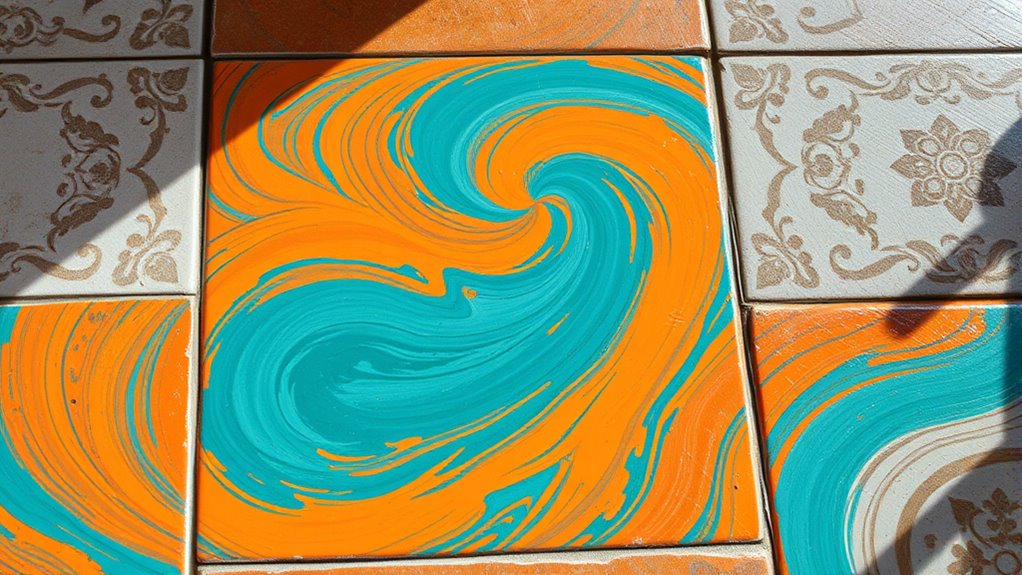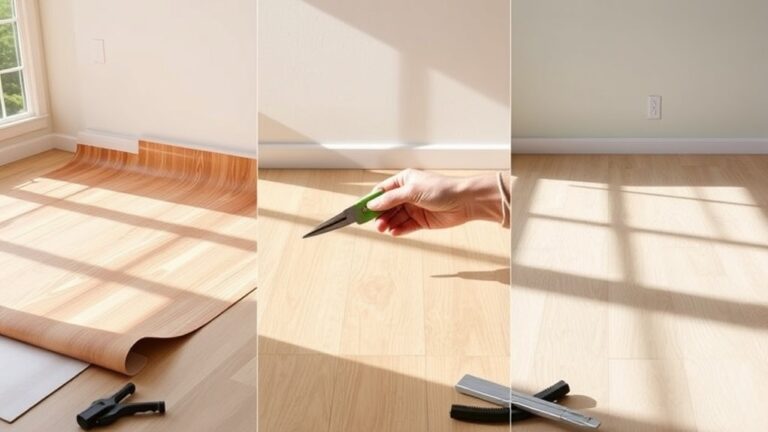You can paint ceramic floor tiles, but it requires proper preparation for the paint to stick and last. Start by cleaning the tiles thoroughly, then lightly sanding the glossy surface to help the primer adhere. Use a primer made for non-porous surfaces, followed by durable paint like epoxy or enamel for best results. Without these steps, your paint may peel or chip. Keep going to discover how to achieve a smooth, long-lasting finish on your tiled floors.
Understanding Ceramic Floor Tiles
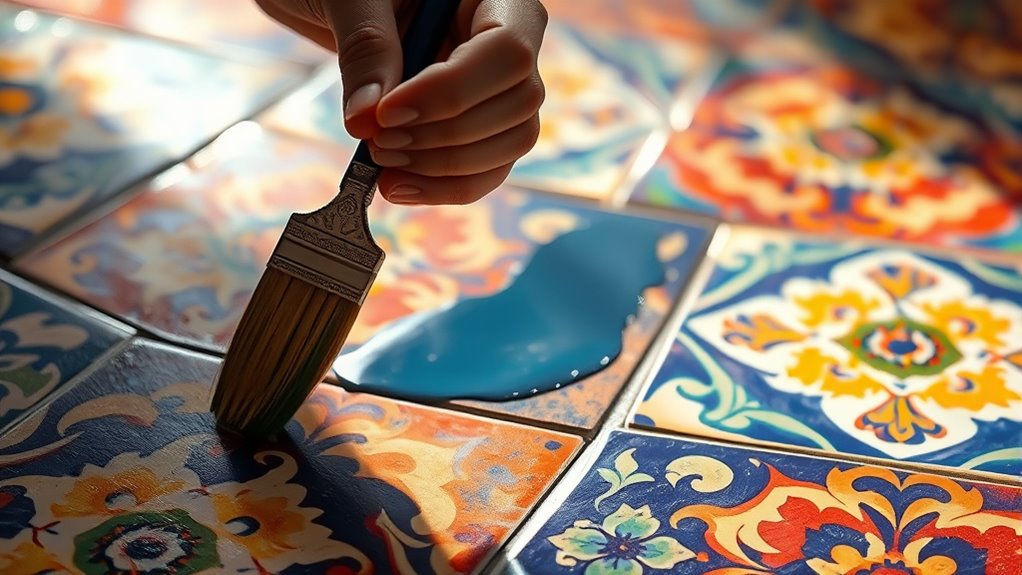
Although ceramic pavimento tiles are known for their durability and ease of maintenance, understanding their composition and surface characteristics is essential before you consider painting them. Ceramic tile characteristics include a hard, glazed surface that resists stains and water, making them ideal for high-traffic areas. This glaze, however, can make paint adhesion tricky without proper preparation. Tile maintenance tips emphasize regular cleaning with non-abrasive products to preserve the glaze’s integrity. You should know that the smooth, glossy finish that protects ceramic tiles also acts as a barrier to paint, so any attempt to paint them requires addressing this challenge. By grasping these details, you gain the freedom to decide if painting is right for your ceramic floors and how to approach it effectively.
Preparing Ceramic Tiles for Painting
Since the glossy glaze on ceramic tiles repels paint, you’ll need to prepare the surface carefully to secure proper adhesion. Start by using effective cleaning techniques—scrub the tiles with a mixture of warm water and mild detergent to remove dirt, grease, and grime. Rinse thoroughly and let them dry completely. Next, lightly sand the tile surface with fine-grit sandpaper to create texture for the paint to grip. After sanding, wipe away dust with a damp cloth and allow the tiles to dry again. Finally, apply a high-quality tile primer designed for glossy surfaces; this critical step seals the tile and improves paint bonding. Taking these preparation steps seriously secures your painted tiles will hold up well, giving you the freedom to customize your floors with confidence.
Choosing the Right Paint for Ceramic Tiles
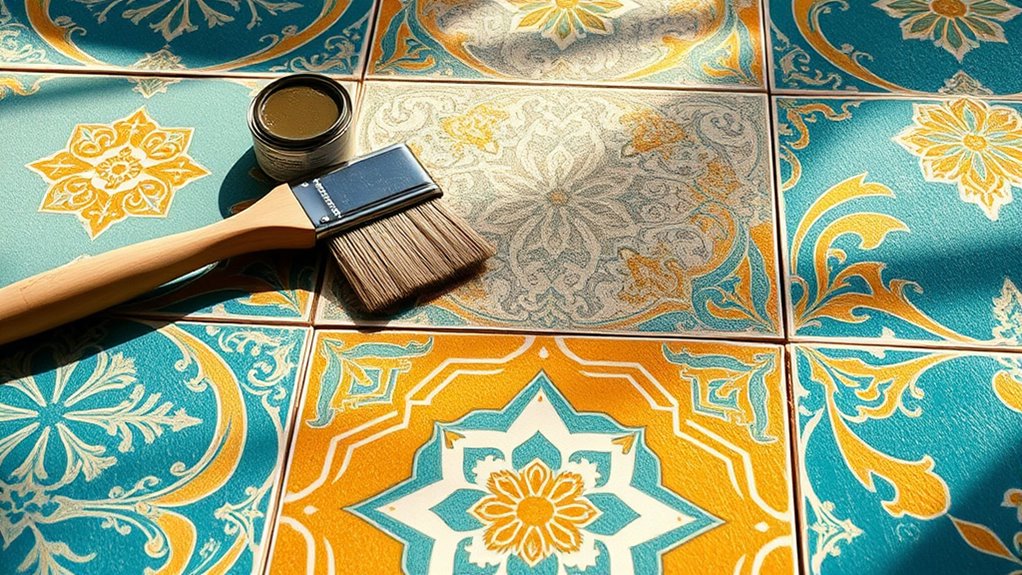
When choosing paint for ceramic tiles, you’ll want to select a product specifically formulated to adhere to smooth, non-porous surfaces. Epoxy and enamel paints are top choices because they provide durability and strong adhesion, essential for floor tiles that endure foot traffic. Acrylic paint can work but usually requires a primer to stick well. For color selection, consider both your space’s style and the paint’s finish—matte, satin, or gloss—to achieve the look you want while ensuring practicality. Keep in mind that lighter colors might show dirt more easily, while darker shades can hide wear. By understanding paint types and carefully selecting your color, you’ll gain the freedom to transform your tiles into a personalized design feature that lasts.
Processo di verniciatura passo dopo passo
Now that you’ve picked the right paint for your ceramic tiles, it’s time to prepare the surface and apply the paint correctly to guarantee lasting results. Start by thoroughly cleaning the tiles to remove dirt and grease, then lightly sand the surface to help the paint adhere better. Wipe away dust with a damp cloth and let it dry completely. Use painter’s tape to protect grout lines and edges. Apply a primer suitable for ceramics to assure durability. Once dry, apply your chosen paint with a high-quality brush or roller, using even strokes and appropriate painting techniques to avoid streaks. Allow the paint to dry between coats, applying two or three layers for full coverage. Proper tile maintenance after painting will keep your floors looking fresh longer.
Tips for Enhancing Paint Durability on Tiles
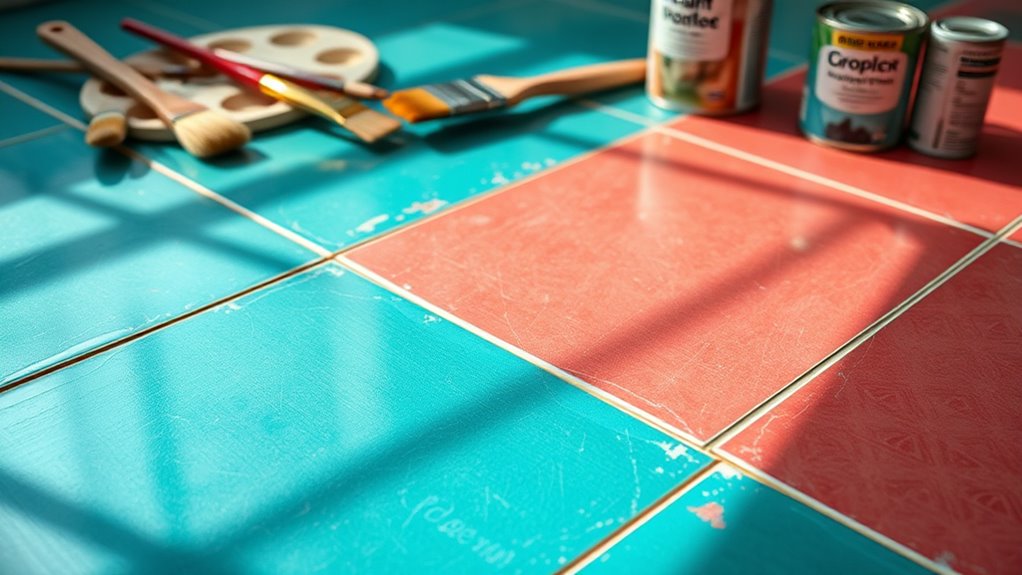
To make sure your paint lasts on ceramic tiles, start by thoroughly cleaning and lightly sanding the surface to help the paint adhere better. Applying a high-quality primer designed for tiles can also boost durability. Finally, sealing your work with a clear protective coating will guard against chips and wear over time.
Surface Preparation Techniques
Proper surface preparation is essential if you want your paint to adhere well and last longer on ceramic floor tiles. Start by thoroughly cleaning the tiles using effective cleaning methods to remove dirt, grease, and grime. This step guarantees the paint bonds directly to the tile surface rather than any residue. Next, employ sanding techniques with fine-grit sandpaper to gently scuff the glossy finish, creating a rough texture that paint can grip onto. Finally, wipe the tiles down with a damp cloth to remove dust from sanding. Remember these key steps:
- Clean tiles thoroughly to eliminate contaminants
- Sand lightly to create a textured surface
- Remove all dust before painting
Protective Coating Options
Although painting ceramic floor tiles can transform their appearance, applying a protective coating is crucial to maintain the paint’s durability against foot traffic, moisture, and cleaning. To achieve long lasting finishes, you’ll want to use high-quality protective sealants specifically designed for floors. Polyurethane or epoxy sealants work well because they create a tough barrier that resists scratches and water damage. Before applying, verify the paint is fully dry and clean to promote adhesion. Use a brush or roller to apply thin, even coats, allowing each layer to cure properly. Multiple layers increase durability without compromising the tile’s look. This approach helps preserve your design’s vibrancy and protects your investment, giving you freedom to enjoy stylish floors without constant touch-ups or worry about wear.
Common Challenges When Painting Ceramic Floors
When you decide to paint ceramic floor tiles, you’ll quickly discover that the process isn’t as straightforward as painting walls or furniture. Ceramic tiles have a slick surface texture, which makes achieving proper color adhesion tricky. Without thorough preparation, paint can peel or chip quickly. You’ll face challenges like:
- Ensuring the tile surface is clean and free of grease or dirt that blocks paint bonding
- Sanding or etching tiles to create texture that helps paint grip
- Choosing the right primer and paint designed for non-porous surfaces to avoid peeling
Understanding these hurdles lets you plan better and avoid frustration. While painting can give your floors a fresh look, it demands patience and the right materials to hold up under foot traffic and cleaning.
Alternatives to Painting Ceramic Floor Tiles
If you’re looking to change the look of your ceramic floor tiles without the hassle of painting, there are several effective alternatives to contemplate. Tile decals offer an easy, removable way to add patterns or colors, letting you personalize your floors without permanent commitment. These decals are durable and water-resistant, making them ideal for high-traffic areas. Another option is vinyl overlays—thin sheets that adhere over your existing tiles, instantly transforming their appearance. Vinyl overlays come in various textures and designs, mimicking wood, stone, or intricate tile patterns. Both options require minimal preparation and can be removed or replaced when you want a new look, giving you the freedom to update your space effortlessly without worrying about paint chipping or long drying times.

